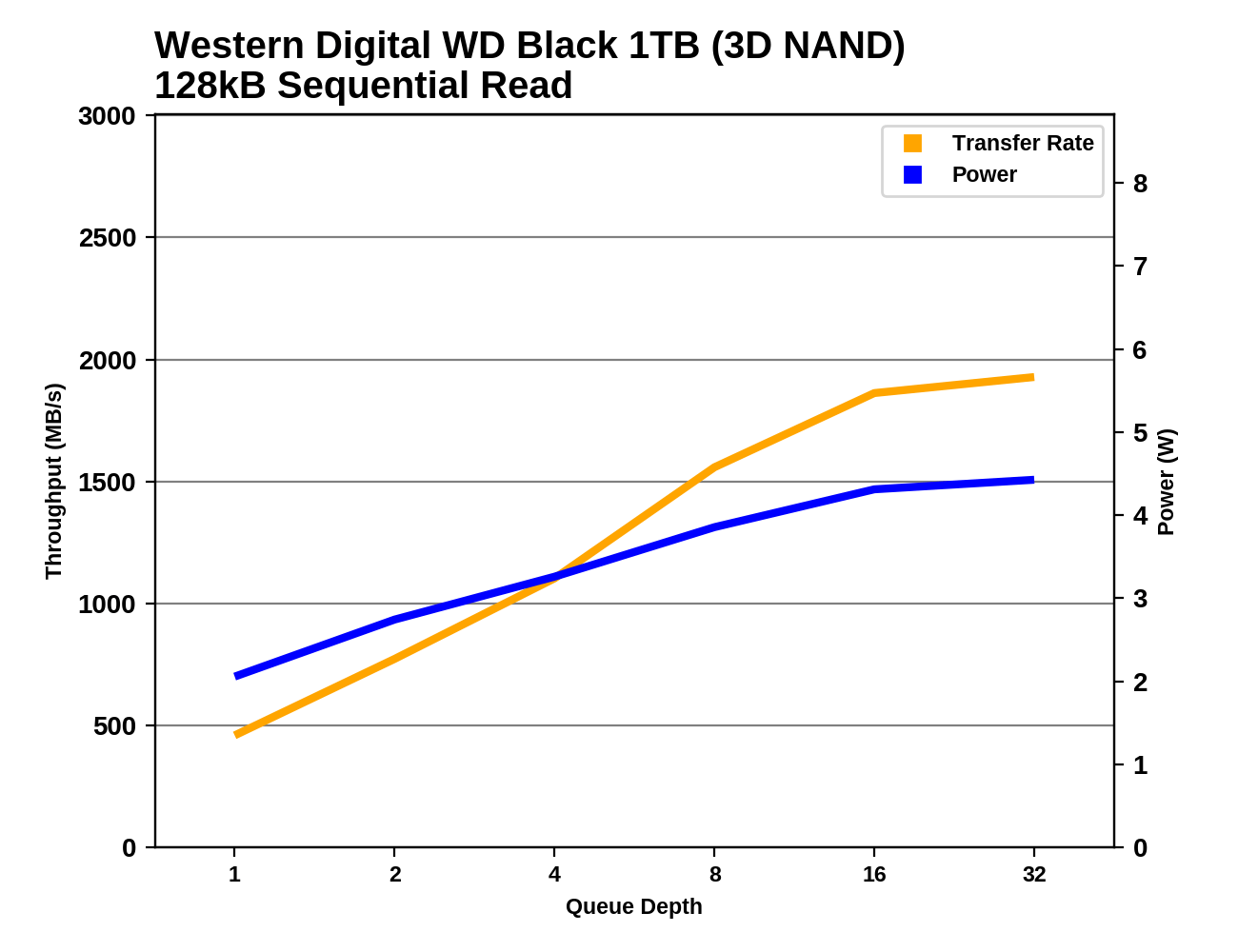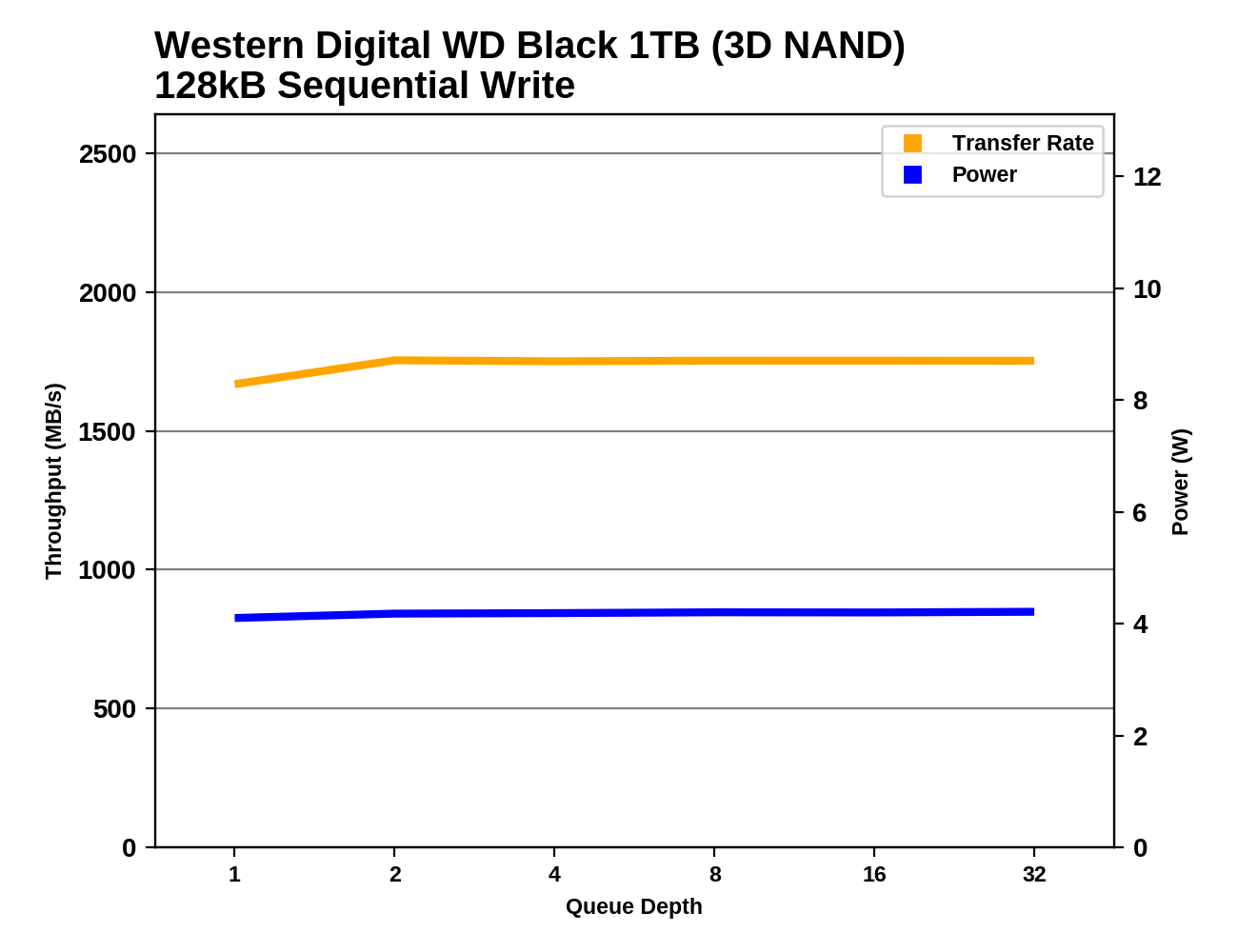The Western Digital WD Black 3D NAND SSD Review: EVO Meets Its Match
by Ganesh T S & Billy Tallis on April 5, 2018 9:45 AM EST- Posted in
- SSDs
- Storage
- Western Digital
- SanDisk
- NVMe
- Extreme Pro
- WD Black
Sequential Read Performance
Our first test of sequential read performance uses short bursts of 128MB, issued as 128kB operations with no queuing. The test averages performance across eight bursts for a total of 1GB of data transferred from a drive containing 16GB of data. Between each burst the drive is given enough idle time to keep the overall duty cycle at 20%.

The burst sequential read performance of the WD Black is several times higher than last year's model, but doesn't come close to setting any records.
Our test of sustained sequential reads uses queue depths from 1 to 32, with the performance and power scores computed as the average of QD1, QD2 and QD4. Each queue depth is tested for up to one minute or 32GB transferred, from a drive containing 64GB of data.

On the sustained sequential read test, the Samsung NVMe drives have a clear lead over the WD Black, which is tied with Toshiba's drives.
 |
|||||||||
| Power Efficiency in MB/s/W | Average Power in W | ||||||||
In terms of power efficiency for sequential reads, the WD Black is much closer to the top drives, with the exception of the Samsung 960 PRO.
 |
|||||||||
The sequential read performance of the WD Black starts out rather poor at QD1 but grows steadily all the way up to QD16, by which point it is outperforming everything except the Optane SSD. The Toshiba XG5 shows similar scaling behavior but can't quite keep pace with the WD Black.
Sequential Write Performance
Our test of sequential write burst performance is structured identically to the sequential read burst performance test save for the direction of the data transfer. Each burst writes 128MB as 128kB operations issued at QD1, for a total of 1GB of data written to a drive containing 16GB of data.

As with the burst random write test, our two samples show surprising differences in burst sequential write speeds. The difference amounts to the WD Black/SanDisk Extreme PRO either being tied for second place with the Samsung 960 EVO, or almost tied with the PM981 that the 960 EVO's replacement will be based on.
Our test of sustained sequential writes is structured identically to our sustained sequential read test, save for the direction of the data transfers. Queue depths range from 1 to 32 and each queue depth is tested for up to one minute or 32GB, followed by up to one minute of idle time for the drive to cool off and perform garbage collection. The test is confined to a 64GB span of the drive.

The sustained sequential write performance of the WD Black is not quite the best, but it is well ahead of everything except the best drives from Samsung and Intel. The WD Black is almost twice as fast as the Toshiba XG5 that uses essentially the same flash.
 |
|||||||||
| Power Efficiency in MB/s/W | Average Power in W | ||||||||
Despite not having the best performance on the sequential write test, the WD Black is the clear winner on the efficiency metric. With power draw of just over 4W it isn't close to being the least power-hungry drive, but it get so much done on that budget that the efficiency score beats everything else.
 |
|||||||||
The sequential write speed of the WD Black is quite steady across the range of queue depths, with just a small increase from QD1 to QD2 and no signs of degraded performance from excessive garbage collection after the SLC cache is full.










69 Comments
View All Comments
Cooe - Friday, April 6, 2018 - link
This is why the 250GB 960 EVO (and inevitably for the new WD Black as well) is far and away the most popular SKU just about everywhere. At around $110-120 vs $80-90, you're only paying a premium of around 20-25% over an equivalent tiered SATA III drive (ala an 850/860 EVO), though yes, you are sacrificing your sequential write speeds past the 13GB Turbowrite cache to just 300MB/s to get that comparatively tiny price premium for good NVMe vs SATA-III ratio.Tbh though in most general consumer PC workloads the above simply isn't an issue, as sustained writes of >13GB are few & far between, and the cache turnover speed while idling is speedy quick. I think this is exactly the reason why Western Digital & SanDisk adopted the kind of handicapped nCache 2.0 into a very Turbowrite-esque system with nCache 3.0 (but more like 850 EVO's simplier static TW cache just a lot bigger, rather a dynamic one like the 960 EVO uses).
Dragonstongue - Thursday, April 5, 2018 - link
competition is good, but not if they all want to keep pricing within a few $ of each other IMO.for nvme/M.2 drives they need to make sure is more universal that it is more plug and play so consumers can be assured it will work on their motherboard as a bootable OS drive right off the bat without driver specific support (quite a few drives quite a few no matter on Intel or AMD chipset seem to have this issue hence they need more plug and play support)
costs more than a normal sata based one (performance is much higher though that does not always mean can see this difference) but having to screw around making the bios/windows able to use the drive in question sucks (not saying this is a problem with this specific model, but it is a problem)
nice write up though ^.^
PeachNCream - Thursday, April 5, 2018 - link
I agree with you on pricing. It would be good if WD had priced their drive a bit lower in order to force Samsung to respond since they have a competitive product, but they have to get a return on development costs so it's safe for them to match Samsung's price. I don't like it because the consumer isn't realizing a benefit in additional competition if neither company budges on cost, but I can understand the business justifications that are probably behind it.Cliff34 - Thursday, April 5, 2018 - link
What I do wish is that the m2 sata drives should be the same price as sata ssd. After all, the specs are the same just diff forms. Too bad for us consumers.The_Assimilator - Friday, April 6, 2018 - link
M.2 SATA drives should cost *less* than their 2.5" equivalents, and the 2.5" drives should simply be an M.2 drives in an enclosure with an M.2-to-SATA connector.Cliff34 - Saturday, April 7, 2018 - link
It should but it doesn't. My guess is because m2 form is a niche market because most computer accept SATA. Therefore, companies can charge more because they can get away with it. Unless there's a huge swing of adoption of m2 form for desktop and laptops, m2 will always cost more than SATA.zodiacfml - Friday, April 6, 2018 - link
True.wr3zzz - Thursday, April 5, 2018 - link
WD's pricing strategy is probably indicative that current demand for NVMe is still outpacing supply.Arbie - Thursday, April 5, 2018 - link
Great article and follow-up analysis of the tests; thanks.iwod - Thursday, April 5, 2018 - link
What are the difference in real world usage? We thought we needed better QD1, and even that doesn't return any significant difference in optane.